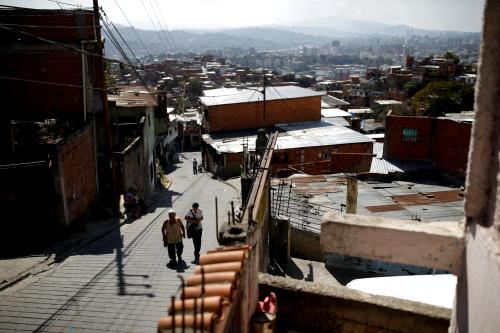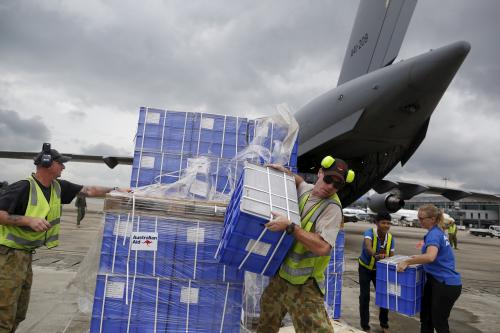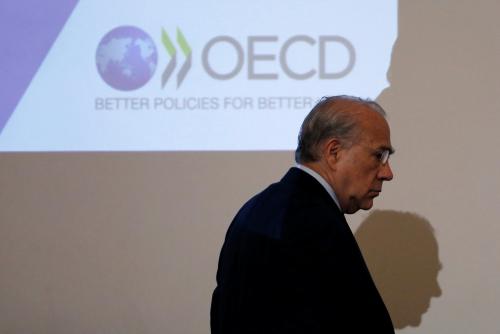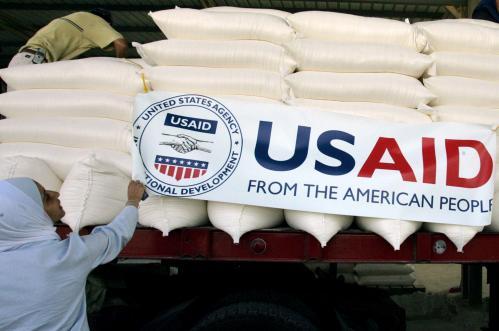For most of its history, the OECD’s Development Assistance Committee (DAC) has been the premier multilateral forum for the world’s major donors to coordinate policies, encourage burden-sharing, and push each other to give more—and more effectively—to developing countries. The concept of Official Development Assistance (ODA) has served as its cornerstone. Its measure of donor effort underpins the DAC’s influence and reputation. We have covered the topic of the reform of the definition of ODA before (here and here). It is an important and ongoing debate and we are pleased to provide an open platform for its continuation. In this correspondence with Susanna Moorhead (the DAC’s chair since February of this year), Simon Scott, a former lead statistician at the OECD, warns that recent evolutions in the method of calculating ODA are undermining its usefulness and will ultimately jeopardize the DAC’s credibility. Brookings Senior Fellow Tony Pipa adds his thoughts on what the fuss is all about.
September 30, 2019
Dear Ms Moorehead,
I write to alert you to major problems with the current definition and reporting rules for official development assistance (ODA). As you know, one of the DAC’s major roles over the past 50 years has been as custodian of the ODA measure.
I worked on the ODA reporting system for over 20 years, both as a reporter in two DAC member countries, and as an OECD official, and I headed the relevant OECD division from 2007 to 2015.
In the months leading up to my retirement from the OECD in July this year, I became increasingly concerned about developments in the ODA reporting rules.
These rules have been the subject of almost constant tinkering over the past five years. The result is, to put it bluntly, a mess. Yet so far, I do not believe that DAC members are fully aware of the scale of the anomalies and inconsistencies created by the combination of decisions, non-decisions, and renounced or abandoned decisions taken on the ODA measure since 2014.
The new “headline” ODA figures break fundamental rules of statistical coherence and comparability. Among other problems, they mix statistical quantities, effectively adding up apples and pears. They record different amounts for the same transactions, depending only on the counterpart. They allow some transactions to be reported in fundamentally different ways, ad libitum. They double-count the risk involved in lending to developing country governments. They fail to meet UN requirements for measuring performance against internationally agreed aid targets.
Given my long association with DAC statistics, I feel obliged to alert users – including DAC members – to these issues. I have therefore posted on the Brookings site here a summary of current problems with the “new ODA” as a statistical measure.
It may seem incredible that the international statistical standard on such a sensitive issue as foreign aid spending could become so distorted and contradictory. How did this happen?
You may wish to form your own opinion by examining the key chronological references in the Annex below. My view is that numerous factors drove this evolution. One was increasing pressures from finance ministries to award more ODA credit for less real outlay. Another was the intrusion of the idea of providing incentives to favoured forms of aid, especially those that offered financial returns to donors. And there has also been a tendency to push technical decisions up to a political level where the necessary specialist expertise is lacking.
Whatever the causes, the “new ODA” is not fit for purpose. It does not fulfil the need of the international community for honest, transparent and internationally comparable figures on aid effort.
Rectifying this situation will require an open and fundamental review of ODA’s concept, definition and reporting rules. If the DAC does not undertake such a review, others will.
Such a review will take time, but in the short term, there is one cause of the present troubles that could easily be rectified: the excessive secrecy of DAC counsels on statistical matters. Neither agendas nor minutes nor documents for these are routinely published for three years. Of course, one can understand the need for the DAC to have some protected space to discuss sensitive questions of aid policy and coordination. But this can hardly apply to the process for developing statistical rules, which needs to be neutral, objective, transparent, and accepted as such by the whole aid community.
The Principles of International Statistical Activities, to which the OECD is an adherent, require making documents for and reports of statistical meetings publicly available. And these principles are widely followed in practice, including by the UN Statistical Commission and the Inter-Agency and Expert Group on SDG Indicators.
If all DAC documents on statistical matters had been published in line with the Principles, technically competent outside experts might have flagged problematic proposals before they were enacted into policy. In any case, publication would definitely have avoided the embarrassing complaints in press and blog articles over recent years about the closed nature of DAC statistical discussions and the need for journalists to glean information from meeting participants on condition of anonymity.
I would therefore urge you to move as soon as possible to full publication of DAC meeting documentation on statistical issues on an accessible website, and to the release of all currently classified DAC statistical papers.
Beyond that, I hope that my Brookings article may help start reflection in the DAC about the need for the fundamental review of the ODA concept, definition and reporting instructions already mentioned. To be successful, such a review would need to ensure broad participation by global experts, and to respect the standards set for developing international statistics, especially those in Principle 8 and in recommendations 2, 6 and 8 of the OECD Recommendation on Good Statistical Practice.
In that perspective, I would encourage you to circulate this letter to DAC members and the DAC secretariat.
In a spirit of transparency, I intend to make this an open letter on 15 November. If you would care to reply, I would, unless you object, also consider your reply to be open for publication. You are equally free to publish this letter on your site from that date.
With best regards,
Simon Scott
Annex – key chronological references
December 2012 – DAC HLM decides to “Maintain the definition of ODA, and only attempt to clarify the interpretation of loans that qualify as ODA” (here, p. 4).
December 2014 – Contradicting its 2012 decision, the HLM decides to fundamentally change ODA loan reporting from flows to grant equivalents from 2019 reporting on 2018 flows. It promises, by then, to replace the rules on reporting forgiveness of loans so as to avoid double-counting risk (here, pp. 6-7).
February 2016 – HLM decides that the grant equivalent methodology it agreed in 2014 will not apply to loans to the private sector. HLM promises new grant equivalent methodology for ODA reporting of these loans, as well as for equity investments and other “private sector instruments” (here, p. 8).
December 2018 – DAC fails to agree on grant equivalent methodology for debt forgiveness and all private sector instruments (loans, equities, guarantees, mezzanine finance, reimbursable grants; here, p. 5). Instead agrees “provisional” reporting rules which revert to flow-based concepts for all these items “for 2018 and 2019 data, and any years afterwards, until the final PSI rules are agreed upon”. This breaks the DAC’s 2014 and 2016 undertakings and fails to properly convert ODA to a grant equivalent measure.
April 2019 – OECD publishes preliminary 2018 ODA data, mixing grant equivalents and flows, and showing the ODA/GNI ratio on this hybrid basis, while suppressing it on the traditional flow basis established in UN General Assembly Resolutions (here, pp. 5-6).
October 16, 2019
Dear Mr Scott,
Thank you for your letter of 30 September 2019 regarding Official Development Assistance (ODA) statistics. It is a pity that you did not discuss the issues you raise with me before you retired from the OECD.
ODA modernisation is not news. Launched by Ministers from DAC members in 2012, it has sought to do what its name suggests – to modernise ODA and hence reflect changing global circumstances. In 2015, the international community’s adoption of the Sustainable Development Goals (SDGs) and Addis Abba Action Agenda added greater urgency to the modernisation process.
The DAC is a consensus-based organisation and political compromises are always and inevitably a bit messy. DAC members, supported by successive DAC Chairs, have taken great care to ensure their decisions are as informed as possible, having consulted broadly, thoroughly reviewed and at times fiercely negotiated the outcomes. It feels rather condescending to suggest that DAC members are not fully aware of the consequences of their decisions (your para. 3). Nor are discussions shrouded in secrecy. Committee work needs to strike a functional balance between the space for members to deliberate, negotiate and reach a compromise – and then to publicise its work as appropriate. As a former staff member of the OECD, you will understand such processes well and that negotiations and decisions combine technical and political considerations. You’ll be pleased to note that WP-STAT is discussing the issue of transparency. I encourage you to check the website for updates. http://www.oecd.org/dac/financing-sustainable-development/development-finance-standards/wp stat.htm
The DAC agreed to move from a cash flow to a grant equivalent system in 2014. It was applied to 2018 data for the first time and reported in 2019. We publish data using both the new grant equivalent and the old flow-based methodologies, which show that applying the new grant equivalent methodology has not led to inflation of the amount of ODA. For some members, their ODA figure is lower under the new system. The new system has many benefits, including a fairer measure of the degree of concessionality and incentivising investments in poorer countries. ODA figures are based on data that are available for public scrutiny. The methodology used is explained in detail on our website. https://www.oecd.org/dac/financing-sustainable-development/modernisation-dac-statistical-system.htm
There is of course unfinished business, of which we are all fully aware. We need a long-term resolution of how to account for private finance instruments and debt relief. We are working to secure a compromise, but this too will need to find a middle path between technical and political considerations. Until we’ve reached agreement, we will continue to publish ODA headline figures that are accounted for – and transparently documented – using both new and old methodologies, so that everyone can see the difference between them.
As I am sure you will appreciate, the work of the DAC has to evolve to meet the growing needs of the international development agenda and we-DAC members, OECD staff and WP-STAT – are committed to ensuring we do all we can to contribute to delivering the SDGs.
Yours sincerely,
Susanna Moorehead
Chair, Development Assistance Committee
Simon Scott responds:
I thank Ms Moorehead for her reply.
I am pleased to hear that the DAC is discussing the issue of the transparency of its proceedings. I hope that it will decide to make documents for and records of statistical meetings publicly available, as mandated by the Principles Governing International Statistical Activities to which the OECD is an adherent.
I am less encouraged by Ms Moorehead’s emphasis on the need to give weight to political considerations. This is, admittedly, a long-standing DAC tradition, and it remains appropriate when the DAC is discussing aid policy, volume, and co-ordination issues. But, as international standards such as the OECD Recommendation on Good Statistical Practice now make clear, it is not appropriate when developing statistical rules, since these need to be neutral, objective and technically sound if the resulting statistics are to be credible.
Unfortunately, the “new ODA” finally agreed on in December 2018 is not credible, or even statistically coherent. As I have pointed out, it mixes apples and pears, adding the flows of some items to the grant equivalents of others. These are two fundamentally different statistical quantities, so their sum is meaningless. Even at the level of individual loans, grant equivalents are reported when they are to the official sector, but flows when they are to the private sector – which makes no sense. Donors can also make arbitrary choices about whether to report on “private sector instruments”, and if so whether to report their net contributions into donor agencies, or those agencies’ net outflows to developing countries. This again leads to meaningless totals.
Moreover, these defective provisions will generate further anomalies and inconsistencies whenever loans are rescheduled, forgiven, or transferred between public and private sectors. So the problems will get worse, and the data become more artificial and opaque, the longer the current system persists.
Some specific problems caused by the new politically-determined rules may become apparent fairly quickly. Once transaction-level “new ODA” data come online at the end of this year, users will start to notice how these overcount aid in ways they would see as unfair or dishonest in other contexts. If, on their tax returns, they declared investment losses but not profits, the taxman might prosecute them for fraud. But the new rules positively require such behaviour when reporting on ODA investments. On the other hand, if they could get a mortgage from a private bank at 2 percent, but took one from a government bank at 2 per cent, they would not expect the government to tell them they should have paid 6, 7 or 9 percent, and have therefore received the equivalent of a massive upfront grant. Yet that is what developing country governments will now be told, given the unrealistic DAC formulas for calculating grant equivalents.
Over the past five years, political considerations within the DAC have unfortunately dominated the process of setting statistical rules to the point where the logic and integrity of the ODA concept have broken down. The results increasingly represent “politically determined figures” rather than recognisable measures of real aid effort. A fundamental review remains urgently necessary. In the meantime, users need to be aware of the many issues with the “new ODA”, including the fact that the DAC now only publishes ODA/GNI ratios on this basis, and no longer makes them available on the traditional, UN-mandated “net disbursements” basis.






Commentary
The ongoing debate on the reform of the definition of Official Development Assistance
November 18, 2019